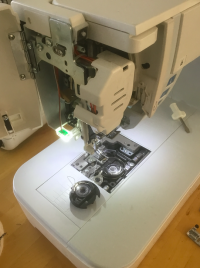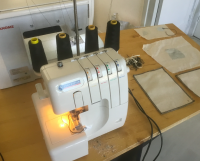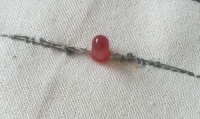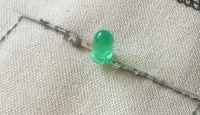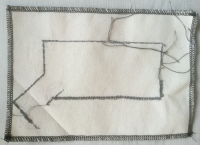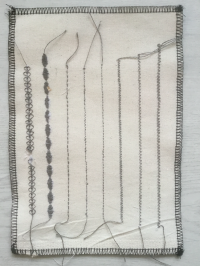Difference between revisions of "Swatch Making"
(→Fails) |
|||
| Line 82: | Line 82: | ||
[[File:sm9.png|200px]] | [[File:sm9.png|200px]] | ||
| + | |||
| + | |||
| + | |||
| + | |||
| + | |||
| + | |||
| + | == Intermediate stages == | ||
| + | |||
| + | Because the sewing machine has a special spool cylinder for the conductive thread installed, the fabric battery holders have to be made later. | ||
| + | |||
== results == | == results == | ||
The first swatch is trying out the conductive thread, as can be seen, in plain stitching, when the stitch length is too small, the stitch gets irregular at this fabric. | The first swatch is trying out the conductive thread, as can be seen, in plain stitching, when the stitch length is too small, the stitch gets irregular at this fabric. | ||
Revision as of 07:33, 17 April 2020
in progress
intro
Making swatches for e-textiles.
The goal is to provide examples for simple and more advanced circuits on fabric.
The possibilities to make "soft" versions of electronic components like switches and battery holders.
preperation
Table with tools
Putting a special spool with conductive thread inside the sewing machine.
Lock Machine
Table with swatches
tools
Machines
- Sewing machine
- lock machine
- soldering station
- scissors
- needles
- stitch undo tool
electronics
- leds
- coin cell batteries
led conductive thread connection
Connecting the legs of the LED to the thread is always a bit of a problem.
There is a method making an eyelet of the leg of the LED and knotting the thread.
I trepide out a new way for me, with a small clamp:
materials
- non conductive materials
- conductive materials
- vlisofix plus aluminium foil
ideas
- fabric battery holder
- making a circuit
- connecting a LED
- making a textile switch
Fails
From errors you learn the most. I thought I would get a better connection by making the stitch length smaller. But then the stitching on the heavy material gets irregular.
That induced me making a swatch of the different stitch length. It turned out that the default stitch length of the machine 2.4 mm was the best. I also tried out some decorative stitches, and the zig zags.
Intermediate stages
Because the sewing machine has a special spool cylinder for the conductive thread installed, the fabric battery holders have to be made later.
results
The first swatch is trying out the conductive thread, as can be seen, in plain stitching, when the stitch length is too small, the stitch gets irregular at this fabric.

